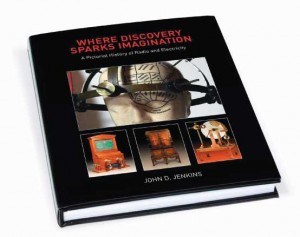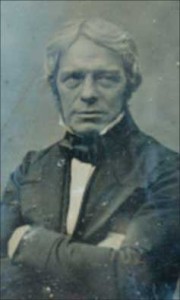 Once in a long while, I see a book that will appeal to many of us, even though it won’t help us wire or inspect. The latest is John D. Jenkins’s Where Discovery Sparks Imagination, A pictorial history of radio and electricity. It offers both stunning photos and intriguing tidbits of fact.
Once in a long while, I see a book that will appeal to many of us, even though it won’t help us wire or inspect. The latest is John D. Jenkins’s Where Discovery Sparks Imagination, A pictorial history of radio and electricity. It offers both stunning photos and intriguing tidbits of fact.
Fact: the first electric motor came early. Going by a strict definition, Michael Faraday built a “proof of concept” motor around 1820. He ran a dc current through a wire whose end dangled in a pool of mercury. The current generated EMF that rotated the wire around a permanent magnet. Our field was moving beyond spark generators and the Leyden jar. Also in 1820, Oersted designed the electromagnet, and less than 20 years later, Samuel Morse saw one and developed the telegraph. It ran on batteries, but it ran across the country.
Most of Faraday’s inventions built on the chemical battery invented by Volta in 1800. They in turn were followed by the first dynamo, and soon the early arc lamp. Not only was each of these an astounding triumph—wouldn’t it have been something to look over their shoulders!—not only was this early work needed before we could get to the simplest bicycle light, but the workmanship was astounding. Before Henry Ford developed his assembly line, manufactured goods looked different.
Jenkins has page after page of luscious pictures, mainly from the American Museum of Radio and Electricity, Bellingham, Washington, which was built around his collection. That “motor”? Naturally, a modern museum won’t offer an exhibit that includes an open pool of mercury. However, Jenkins reproduces a picture of Faraday’s design from an 1821Quarterly Journal of Science, alongside a picture of Faraday’s 1931 induction generator and Joseph Henry’s 1931 reciprocating dc motor. The elegant devices pictured go back to the eighteenth century. Better yet, he did not collect electrical antiques for prettiness alone; he’s an E.E., and enough of a teacher to share wonderful stories around his finds.

Photo 1. Michael Faraday was photogenic; but Jenkins shows his inventions rather
Jenkins is that luckiest of hobbyists, the man who made a good-enough living that he could collect the items that fascinate him. Eventually he retired and devoted himself to the history of radio and other scientific fields.
Not myself being a radio collector or antiquarian, two parts electricity to one part radio and telephone pictures would have suited me better than the reverse, which is what I found. Admittedly, the shots of old radio consoles are pretty. Even so, I would have preferred more electrical generation, distribution, and other utilization equipment, and yet more diagrams. Arrows and labels could have clarified, say, which piece of an ancient static electricity generator was a handle and which an electrode for drawing off a spark.
I’m sure that quite a few of us have readA Connecticut Yankee in King Arthur’s Court, by Mark Twain (a friend of Tesla’s!). The hero is a mid-nineteenth century Yankee engineer thrown back into the days of knights and superstition. He recreates the technology of his time from the ground up. Given the demands of twenty-first century engineering, the feat seems far beyond a modern P.E., even if it may not have been beyond an engineer of 100-plus years ago. But how did the hero achieve this? Twain, a.k.a. Clemens (not “Clements”), was a master storyteller, and also a riverboat pilot, surveyor, and prospector. All these additional skills still did not exactly make him an engineer, so it’s not surprising thatConnecticut Yankeeis a bit fuzzy on details. Besides, Clemens was a journalist, not a professor.
Jenkins too writes for a general audience. Consequently,Where Discovery Sparks Imaginationalso sometimes leaves me guessing. If I want all the answers, I can visit the museum. Until then, I have a cocktail table book that’s a bit more than pretty pictures.
The well-made 218-page hardcover can be ordered from a bookstore, or directly from the museum,WWW.AMRE.US for $35.











Find Us on Socials